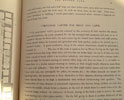1836 - 1886. The Reform Club:
ITS FOUNDERS AND ARCHITECT. BY LOUIS FAGAN, Of the Department of Prints and Drawings, the British Museum. Honorary Member of the Society of Engravers of France; Author of "The Life of Sir Anthony Panizzi, "K.C.B.;" "The Art of Michelangelo;" "Catalogue Raisonne of the Works of William Woollett;" "Collectors Marks," "Raphael's Sonnett;" etc., etc. WITH ILLUSTRATIONS BY THE AUTHOR. LONDON Bernard Quaritch, 15 PICCADILLY 1887.
Large 4vo. 1fep with frontis illustration of the Reform Club library on verso. The Title page in red and black text. The verso with a printers device. List of Illustrtions. [1] (1)vi-viii List of 143 illustrations. 1 page Preface by Louis Fagan. [1] (1)2-143. [1] (1)ii-xiii Index. [1] 1fep. Except for a little water-staining on the borders of the frontis, everything as new. The cover has been very sympathetically rebound recently in the same blue cloth cover as the original and the original gilt lettering on boards and spine. Almost as new.
- The 19th century brought an explosion in the popularity of gentlemen's clubs, particularly around the 1880s. At their height, London had over 400 such establishments. This expansion can be explained in part by the large extensions of the franchise in the Reform Acts of 1832, 1867, and 1885. Each time, hundreds of thousands more men were qualified to vote, and it was common for them to feel that they had been elevated to the status of a gentleman, thus they sought a club. The existing clubs, with strict limits on membership numbers and long waiting lists, were generally wary of such newly enfranchised potential members, and so these people began forming their own clubs. Each of the three great Reform Acts corresponded with a further expansion of clubs, as did a further extension of the franchise in 1918. Many of these new, more inclusive clubs proved just as reluctant as their forebears to admit new members when the franchise was further extended. An increasing number of clubs were characterised by their members' interest in politics, literature, sport, art, automobiles, travel, particular countries, or some other pursuit. In other cases, the connection between the members was membership of the same branch of the armed forces, or the same school or university. Thus, the growth of clubs provides an indicator as to what was considered a respectable part of the Establishment at the time. There are perhaps some 25 traditional London gentlemen's clubs of particular note, from The Arts Club to White's, Brooks etc. The Reform Club on the south side of Pall Mall in central London was founded on February 2nd 1836 by Edward Ellice, Member of Parliament for Coventry and Whig Whip, whose riches came from the Hudson's Bay Company, but whose zeal was chiefly devoted to securing the passage of the Reform Act 1832. Significantly, The Reform Club it was the first to change its rules to include the admission of women on equal terms in 1981. It also attracts a significant number of foreign members, such as diplomats accredited to the Court of St. James's. The Reform was known for the quality of its cuisine. Its first chef being Alexis Soyer, the first celebrity chef and cookery book author. He was followed by Charles Elme Francatelli, a former Head Chef of Queen Victoria. This a very handsome copy printed when the Club was at its height.






click on image to enlarge

Antiquarian category
ref number:
11209